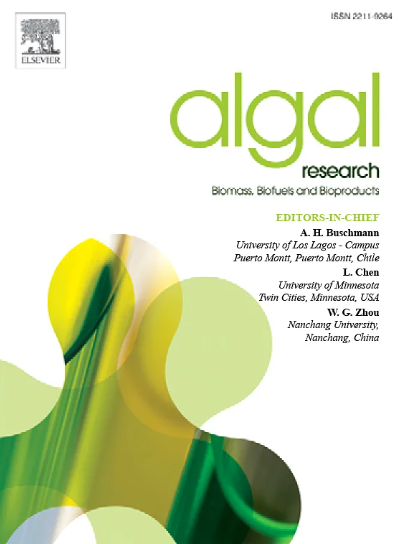A special lycopene ε-cyclase from Chromochloris zofingiensis ATCC 30412 with multiple catalytic functions
IF 4.6
2区 生物学
Q1 BIOTECHNOLOGY & APPLIED MICROBIOLOGY
Algal Research-Biomass Biofuels and Bioproducts
Pub Date : 2025-02-21
DOI:10.1016/j.algal.2025.103974
引用次数: 0
Abstract
The cyclization of lycopene catalyzed by lycopene cyclases (LCYs) represents a pivotal step in forming α-branch or β-branch carotenoids. However, the catalytic functions of LCYs are species-specific. In this study, the LCYs of Chromochloris zofingiensis ATCC 30412, including lycopene ε-cyclase (CzLCYE) and lycopene β-cyclase (CzLCYB), were characterized by sequence alignment, subcellular localization, and function identification. The sequence alignment revealed the presence of several conserved motifs in CzLCYE and CzLCYB, exhibiting high similarity to the LCYs of other organisms. Subcellular localization experiments illustrated the chloroplast localization of these two enzymes. Functional complementation assays in Escherichia coli demonstrated that CzLCYB exhibited merely β-cyclase activity. Interestingly, CzLCYE displayed strong ε-monocyclase activity, moderate β-monocyclase activity, and weak β, β-bicyclase activity, which are rarely found in other organisms. Further, the structures of CzLCYE complexes were built to identify the essential amino acid residues within the substrate-binding pocket. Site-directed mutagenesis experiments revealed the significant roles of TYR140, PHE321, and THR337 in maintaining CzLCYE activity as well as LEU236, PHE245, PHE405, and LEU488 in β-ring formation. However, the mutation of THR205 to ALA enhanced β, β-bicyclase activity. These findings reveal the special catalytic functions of CzLCYE, contributing to a deeper understanding of carotenoid biosynthesis in C. zofingiensis.

求助全文
约1分钟内获得全文
求助全文
来源期刊

Algal Research-Biomass Biofuels and Bioproducts
BIOTECHNOLOGY & APPLIED MICROBIOLOGY-
CiteScore
9.40
自引率
7.80%
发文量
332
期刊介绍:
Algal Research is an international phycology journal covering all areas of emerging technologies in algae biology, biomass production, cultivation, harvesting, extraction, bioproducts, biorefinery, engineering, and econometrics. Algae is defined to include cyanobacteria, microalgae, and protists and symbionts of interest in biotechnology. The journal publishes original research and reviews for the following scope: algal biology, including but not exclusive to: phylogeny, biodiversity, molecular traits, metabolic regulation, and genetic engineering, algal cultivation, e.g. phototrophic systems, heterotrophic systems, and mixotrophic systems, algal harvesting and extraction systems, biotechnology to convert algal biomass and components into biofuels and bioproducts, e.g., nutraceuticals, pharmaceuticals, animal feed, plastics, etc. algal products and their economic assessment
 求助内容:
求助内容: 应助结果提醒方式:
应助结果提醒方式:


